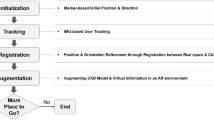Abstract
A mobile augmented reality system for visual guidance of craftsmen is presented. The integrated pico-projector displays constructional information within the workers field of vision. It displays borehole locations in correct world pose and helps workers aligning a drill perpendicular to a wall. To create assisting images using coordinate transformation, rtab-SLAM and camera-projector calibration determine the relative pose between the environment and the projector. To evaluate the systems usability, a user study was performed on drill aligning. It proves that the system increases task performance speed, improving accuracy in horizontal movements but indifferent in vertical movements compared to unassisted performances.
Access this chapter
Tax calculation will be finalised at checkout
Purchases are for personal use only
Similar content being viewed by others
References
Azuma, R. (1997). A Survey of Augmented Reality. Presence: Teleoperators and Virtual Environments, 6, 355–385.
Bringeland, S., Heine, T., Hoffmann, M., Stein, T., & Deml, B. (2016). Ergonomische Evaluation eines Handwerker-Kraftassistenzsystems, Arbeit in komplexen Systemen—Digital, vernetzt, human?!. Tagungsband 62. Frühjahrskongress der Gesellschaft für Arbeitswissenschaft. GFA Press, Dortmund.
Doshi, A., Smith, R., Thomas, B. H., & Bouras, C. (2016). Use of projector based augmented reality to improve manual spot-welding precision and accuracy for automotive manufacturing. Advanced Manufacturing Technology, 1–15.
Falcao, G., Hurtos, N., & Massich, J. (2008). Plane-based calibration of a projector-camera system. VIBOT Master, 1–12.
Frese, U., Wagner, R., & Röfer, T. (2010). A SLAM Overview from a User’s Perspective. KI - Künstliche Intelligenz, 24, 191–198, 2010.
Gavaghan, K., Anderegg, S., Peterhans, M., Oliveira-Santos, T., & Weber, S. (2012). Augmented reality image overlay projection for image guided open liver ablation of metastatic liver cancer. Lecture Notes in Computer Science: Augmented Environments for Computer-Assisted Interventions 7264 (pp. 36–46). Berlin, Heidelberg: Springer.
Hart, S. G., & Staveland, L. E. (1988). Development of NASA-TLX (Task load index). Results of empirical and theoretical research. Human mental workload (Advances in psychology) (Vol. 52, pp. 139–183). Elsevier.
Kobler, J.-P., Hussong, A., & Ortmaier, T. (2010). Mini-Projektor basierte Augmented Reality für medizinische Anwendungen. Tagungsband der 9. Jahrestagung der Deutschen Gesellschaft für Computer- und Roboterassistierte Chirurgie e.V. (CURAC), (pp. 115–118).
Van Krevelen, D., & Poelman, R. (2010). A Survey of Augmented Reality Technologies. Applications and Limitations. The International Journal of Virtual Reality, 9, 1–20.
Labbé, M., & Michaud, F. (2014). Online global loop closure detection for large-scale multi-session graph-based SLAM. In Proceedings of the IEEE/RSJ International Conference on Intelligent Robots and Systems, (pp. 2661–2666).
Laugwitz, B., Held, T., & Schrepp, M. (2008). Construction and evaluation of a user experience questionnaire. In A. Holzinger (Ed.), Proceedings of USAB’08 (pp. 63–76). Berlin, Heidelberg, Springer.
Ornkloo, H., & von Hofsten, C. (2007). Fitting objects into holes. On the development of spatial cognition skills. Developmental psychology, 43(2), 404–416.
Schrepp, M., Hinderks, A., & Thomaschewski, J. (2014). Applying the user experience questionnaire (UEQ) in different evaluation scenarios. In A. Marcus (Ed.), Design, user experience, and usability. Theories, methods, and tools for designing the user experience. DUXU. Lecture Notes in Computer Science 8517. Cham: Springer.
Wiedemeyer, T. (2015) IAI Kinect2. https://github.com/code-iai/iai_kinect2. Institute for Artificial Intelligence, University Bremen. Accessed June 12, 2015.
Wu, J., Wang, M., Liu, K., Hu, M., & Lee, P. (2014) Real-time advanced spinal surgery via visible patient model and augmented reality system. Computer Methods and Programs in Biomedicine, 113, 869–881.
Acknowledgements
This research received funding by the Federal Ministry of Education and Research of Germany (BMBF 16SV6175).
Author information
Authors and Affiliations
Corresponding author
Editor information
Editors and Affiliations
Rights and permissions
Copyright information
© 2018 Springer Nature Switzerland AG
About this chapter
Cite this chapter
Nuelle, K., Bringeland, S., Tappe, S., Deml, B., Ortmaier, T. (2018). Mobile Augmented Reality System for Craftsmen. In: Karafillidis, A., Weidner, R. (eds) Developing Support Technologies. Biosystems & Biorobotics, vol 23. Springer, Cham. https://doi.org/10.1007/978-3-030-01836-8_17
Download citation
DOI: https://doi.org/10.1007/978-3-030-01836-8_17
Published:
Publisher Name: Springer, Cham
Print ISBN: 978-3-030-01835-1
Online ISBN: 978-3-030-01836-8
eBook Packages: Computer ScienceComputer Science (R0)




